China is about to become a big deal again on the global stage. According to the latest number crunching by Bloomberg using IMF forecasts, China’s economic comeback is on track to outdo the G-7 countries combined.
That’s right! We’re looking at China leading with a projected 21% of global economic growth from now through 2029. Compare that to a close 20% for the mighty G-7 and nearly double the U.S.’s 12%. Think about it, guys. In the grand scheme of things, 75% of the world’s growth will be thanks to just 20 countries, with the top four—China, India, the U.S., and Indonesia—pulling more than half of that weight.
Real Numbers, Real Growth
So, early this year, China’s economy soared, hitting a 5.3% increase in GDP during the first quarter, topping expectations of a 4.6% rise. This isn’t just another dry stat from the National Bureau of Statistics. It’s a sign of real muscle. According to NBS spokesperson Sheng Laiyun, this robust start sets the stage for meeting annual economic goals, although he tossed in a caution that the foundation isn’t rock-solid yet.
On the ground, this translates to some heavy lifting in sectors like high-tech manufacturing. I’m talking a 6.1% surge in industrial production, with standout jumps in 3D printing gear, EV charging setups, and electronic parts — all up by about 40% from last year. This is making waves internationally, as shown by the spike in China’s manufacturing PMI, which recently marked its best performance in over a year.
But hey, it’s not all rosy.
While factories are buzzing, consumers aren’t rushing to open their wallets. Retail sales did see a 4.7% boost in early 2024, fueled by sports, entertainment, and yes, even booze and smokes. And let’s not forget a 4.5% bump in spending on the essentials; Factories, roads, power grids.
Yet, beneath this bustling activity, there’s a mismatch that economists are quick to point out, manufacturers are on a tear while everyday folks are more sideline than headline.
Risky Business and Big Bets
Dig deeper, and you’ll see the high stakes in this economic poker game. China is betting big on industries like EVs, solar tech, and batteries. It’s a play that’s paying off as exports soar, but it’s not without its dice rolls, especially with the U.S. and EU wary of China’s market muscle potentially flooding their turf. U.S. Treasury Secretary Janet Yellen’s recent words during her China visit were a clear nudge. Play fair, or tariffs could rain on this parade.
Then there’s the homefront, where the real estate scene is more bust than boom. Property investment took a 9.5% dive early in the year, with new property sales down a stark 27.6%. And as housing prices drop, so does consumer confidence, which is already scraping what some are calling “the historical bottom.”
The international vibe isn’t much better.
Foreign investment is in a bit of a freefall, with a sharp 10.4% decline in early 2024. Despite this, China’s leaders are putting on the charm offensive, with top-level talks aimed at boosting trade and cooperation. Whether it’s wooing Germany’s Chancellor or schmoozing with U.S. CEOs, it’s clear that China’s doors are open for business.
So, what’s the bottom line? China’s economic engine is revving up, but it’s a complex machine with plenty of moving parts, some that could use a bit more grease.





